I realize that it’s been some time since I posted here. I have been deep in the subterranean autoharp mines stoking the steam driven sawdust grinders, board stretchers, and string breakers that produce the custom instruments that I create for my many wonderful customers… I only just emerged for a hot shower, a cold adult beverage and to catch up on some news of the world. Building custom stringed instruments and strumming newly minted autoharps takes me to a comforting place apart from much of the disturbing social, political, and environmental reports. Like our music, it is a soothing embrocation to be applied to the psychological pains and strains of daily life.
So, what have I been doing? Besides completing some autoharp orders, I am currently involved in long term projects creating two non-traditional zithers, one for a musician who preforms classical Indian ragas and another for a Nashville based multi-instrumentalist.
 Along the way I have made a couple of improvements on my “Child ‘Harps”. I had been making slotted chord bar holders by cutting down the manufactured plastic holders once produced by Oscar Schmidt. These work well but are a bit noisy when the wooden bars “clack” against the hard plastic. My newer Child ‘Harps now have the quieter Delrin and steel pin combs as on my standard sized autoharps.
Along the way I have made a couple of improvements on my “Child ‘Harps”. I had been making slotted chord bar holders by cutting down the manufactured plastic holders once produced by Oscar Schmidt. These work well but are a bit noisy when the wooden bars “clack” against the hard plastic. My newer Child ‘Harps now have the quieter Delrin and steel pin combs as on my standard sized autoharps.
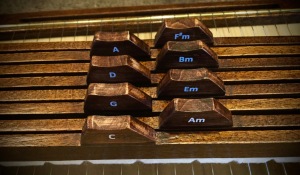 Child ‘Harps have carried seven chords in two rows. I now offer eight chords. Here is the G/D diatonic version.
Child ‘Harps have carried seven chords in two rows. I now offer eight chords. Here is the G/D diatonic version.
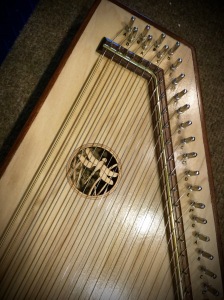 As with the Child ‘Harps’ larger siblings, laser cut sound hole rosettes are popular. there is a variety of styles available in this smaller size for this smaller autoharp.
As with the Child ‘Harps’ larger siblings, laser cut sound hole rosettes are popular. there is a variety of styles available in this smaller size for this smaller autoharp.
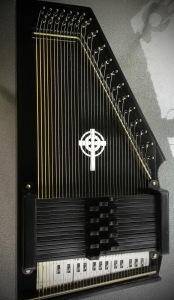 A more recent build is this thirty-six string, fifteen chord chromatic I built for a gentleman just beginning his autoharp journey. His preferences included a Celtic cross sound hole rosette, an all black finish, and a salvaged OS tuning label at the anchor end.
A more recent build is this thirty-six string, fifteen chord chromatic I built for a gentleman just beginning his autoharp journey. His preferences included a Celtic cross sound hole rosette, an all black finish, and a salvaged OS tuning label at the anchor end.

He plans to play his new autoharp horizontally, on his lap, and strumming below the chord bars. For that, I moved the chord set closer to the angled bridge to allow more space below.
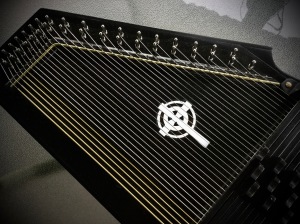 This instrument resembles the old black model A autoharps of the past but features all of my modern improvements for tone, volume, stability, and play ability.
This instrument resembles the old black model A autoharps of the past but features all of my modern improvements for tone, volume, stability, and play ability.
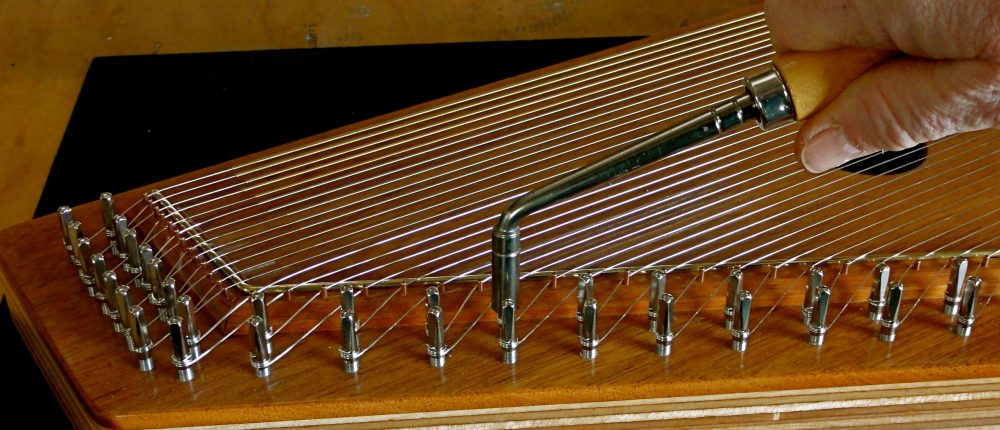
 A musician from Tennessee recently commissioned this custom autoharp with several features that, to me, are very similar to the fifteen chord Oscar Schmidt and ChromaHarp models of the past. Over the years those A style chromatic models with their round sound holes, fifteen chord bars in two rows, and laminated soundboards underwent many improvements by their manufacturers. This musician seems to favor that style of instrument and was able to specify several construction, setup, and cosmetic improvements to suit his preferences and playing style.
A musician from Tennessee recently commissioned this custom autoharp with several features that, to me, are very similar to the fifteen chord Oscar Schmidt and ChromaHarp models of the past. Over the years those A style chromatic models with their round sound holes, fifteen chord bars in two rows, and laminated soundboards underwent many improvements by their manufacturers. This musician seems to favor that style of instrument and was able to specify several construction, setup, and cosmetic improvements to suit his preferences and playing style.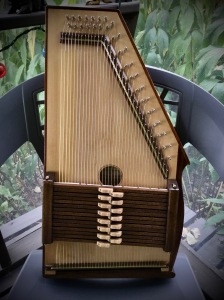 Most of my builds have been set up for playing in the area above the chord bars with the high treble strings unobstructed by the chord bar covers. This chord set is positioned closer to the tuning pins to permit play below the chord bars at the anchor end. Many of the old OS A models were arranged this way until playing the instrument upright became common and the bar set was moved south by their owners or the factories. This instrument is designed to be played on the musician’s lap with the left hand at the chords and the right hand playing near the anchor bridge.
Most of my builds have been set up for playing in the area above the chord bars with the high treble strings unobstructed by the chord bar covers. This chord set is positioned closer to the tuning pins to permit play below the chord bars at the anchor end. Many of the old OS A models were arranged this way until playing the instrument upright became common and the bar set was moved south by their owners or the factories. This instrument is designed to be played on the musician’s lap with the left hand at the chords and the right hand playing near the anchor bridge.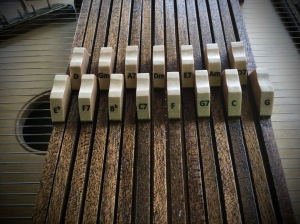 The old A models chord bars and buttons were 5/16 inches wide. I reduced these bars to a 1/4 inch width to narrow the array while leaving the buttons wide enough as to not require caps. The maple buttons are of a similar style to the older fifteen chord ‘harps and the chords are selected and arranged to the musician’s preference. He prefers a higher action (the height of the felt above the strings) for more vigorous chording. I set the travel high as requested but included extra self-sticking felt strips for under the covers should he choose to adjust the bars lower.
The old A models chord bars and buttons were 5/16 inches wide. I reduced these bars to a 1/4 inch width to narrow the array while leaving the buttons wide enough as to not require caps. The maple buttons are of a similar style to the older fifteen chord ‘harps and the chords are selected and arranged to the musician’s preference. He prefers a higher action (the height of the felt above the strings) for more vigorous chording. I set the travel high as requested but included extra self-sticking felt strips for under the covers should he choose to adjust the bars lower. The modern improvements in the construction of this instrument include a solid spruce soundboard with tuned bracing, a one piece laminated frame, and quiet chord bars mounted on Delrin and steel pin combs. The chord bars, covers, side veneer, bridges, and tailpiece are made of African mahogany that has been stained dark brown. The musician requested that I not apply note labels under the tuning pins so I included a wooden tuning strip/duster that can be positioned under the strings to aid tuning.
The modern improvements in the construction of this instrument include a solid spruce soundboard with tuned bracing, a one piece laminated frame, and quiet chord bars mounted on Delrin and steel pin combs. The chord bars, covers, side veneer, bridges, and tailpiece are made of African mahogany that has been stained dark brown. The musician requested that I not apply note labels under the tuning pins so I included a wooden tuning strip/duster that can be positioned under the strings to aid tuning.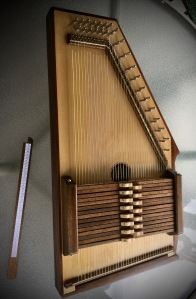 A custom built autoharp such as this can be built with the preferred features and options that improve playability and appearance. Sometimes it comes with a surprise: as the owner noted, “I was in shock at how light it is!”.
A custom built autoharp such as this can be built with the preferred features and options that improve playability and appearance. Sometimes it comes with a surprise: as the owner noted, “I was in shock at how light it is!”.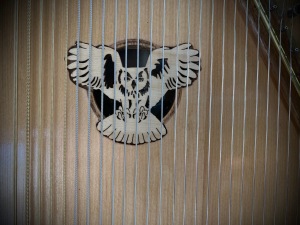 I have recently located a source of laser cut ornaments in a variety of subjects. Most are too large to inlay as a sound hole rosette but with many of them, I can trim away the bordering areas for a good fit.
I have recently located a source of laser cut ornaments in a variety of subjects. Most are too large to inlay as a sound hole rosette but with many of them, I can trim away the bordering areas for a good fit.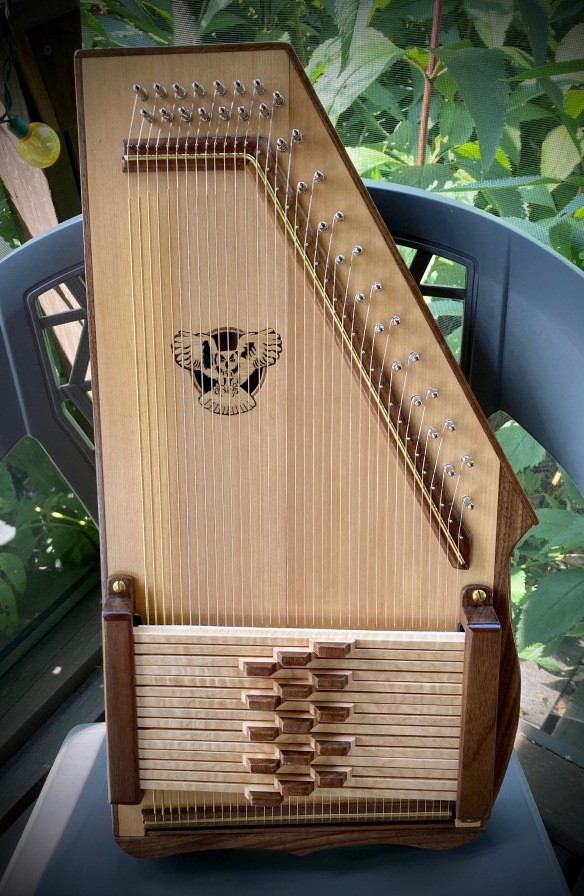 Here is a new custom thirty-six string chromatic autoharp. My standard, one piece pinblock frame features a spruce sound board, laminate back, and 3/16 inch thick walnut veneered sides. Matching walnut was also used for the brass rod-capped bridges, tail piece, chord bar covers, bridges and chord bar covers.
Here is a new custom thirty-six string chromatic autoharp. My standard, one piece pinblock frame features a spruce sound board, laminate back, and 3/16 inch thick walnut veneered sides. Matching walnut was also used for the brass rod-capped bridges, tail piece, chord bar covers, bridges and chord bar covers.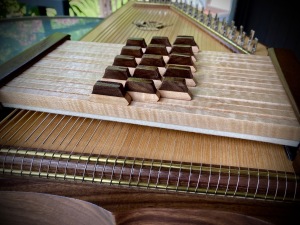 The fifteen chord bars are made of curly maple. The contrasting buttons are capped with walnut.
The fifteen chord bars are made of curly maple. The contrasting buttons are capped with walnut.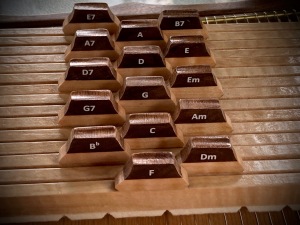
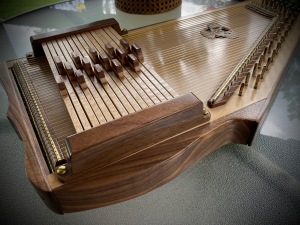
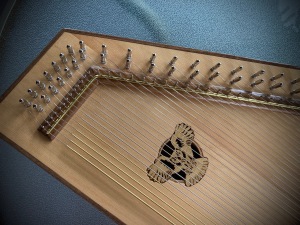

 Here is a new custom thirty-seven string chromatic autoharp that I built for a beginning autoharp musician here in Ohio. She plans to play worship and folk music to accompany herself and other vocalists. Because she resides within easy driving distance to Darke County, she and her husband could visit, view the many features and options available, and order the special instrument that is to be a birthday gift from her family.
Here is a new custom thirty-seven string chromatic autoharp that I built for a beginning autoharp musician here in Ohio. She plans to play worship and folk music to accompany herself and other vocalists. Because she resides within easy driving distance to Darke County, she and her husband could visit, view the many features and options available, and order the special instrument that is to be a birthday gift from her family. I always try to make each of my instruments unique so that my clients have a special instrument unlike any other. Of course there are constraints like scale, setup, and structure, but I like to give folks choices. This musician chose a western red cedar soundboard, maple chord bars, and curly cherry for the bridges, bar holders, buttons, and side trim.
I always try to make each of my instruments unique so that my clients have a special instrument unlike any other. Of course there are constraints like scale, setup, and structure, but I like to give folks choices. This musician chose a western red cedar soundboard, maple chord bars, and curly cherry for the bridges, bar holders, buttons, and side trim.
 A weeping heart was chosen for the sound hole. I made this by inlaying a 1/8″ thick cherry heart shape into the 1/4″ thick soundboard and then removing the inner heart shape leaving a 1/8″ wide cherry border.
A weeping heart was chosen for the sound hole. I made this by inlaying a 1/8″ thick cherry heart shape into the 1/4″ thick soundboard and then removing the inner heart shape leaving a 1/8″ wide cherry border.
 The fifteen maple chord bars feature cherry buttons with the lateral dishing (rather than longitudinal dishing) preferred by the player. They move on #6 steel pins set into Delrin bases. The chord felt is yet uncut pending the player’s preferences.
The fifteen maple chord bars feature cherry buttons with the lateral dishing (rather than longitudinal dishing) preferred by the player. They move on #6 steel pins set into Delrin bases. The chord felt is yet uncut pending the player’s preferences. Structurally, this A style autoharp is built with a one piece laminated pinblock frame and a 1/4″ thick laminated birch back. Lately, I have been routing away unnecessary areas inside the frame to increase the interior volume. This, along with some tuned bracing, improves tone and volume.
Structurally, this A style autoharp is built with a one piece laminated pinblock frame and a 1/4″ thick laminated birch back. Lately, I have been routing away unnecessary areas inside the frame to increase the interior volume. This, along with some tuned bracing, improves tone and volume. My most recent instrument is this custom chromatic autoharp commissioned by a musician here in Ohio.
My most recent instrument is this custom chromatic autoharp commissioned by a musician here in Ohio. The twenty-one maple chord bars are capped with walnut buttons and are mounted upon combs made of #6 bridge pins and Delrin bases. Just to be different, I kinda hybridized the chord bar covers by making a shell out of walnut and very thin birch plywood. Its top surface is veneered with sequence-matched walnut burl. There is no distinct advantage for making it this way but the larger areas of felt damping on the underside seem to make the chord bars quieter.
The twenty-one maple chord bars are capped with walnut buttons and are mounted upon combs made of #6 bridge pins and Delrin bases. Just to be different, I kinda hybridized the chord bar covers by making a shell out of walnut and very thin birch plywood. Its top surface is veneered with sequence-matched walnut burl. There is no distinct advantage for making it this way but the larger areas of felt damping on the underside seem to make the chord bars quieter. The side trim and bridges are walnut.
The side trim and bridges are walnut.
 With few exceptions, autoharps have been made of wood. Solid and laminated hardwood frames have been enclosed by hardwood, softwood, and plywood with the builder’s and player’s personal preferences guiding the combination. Decades of research and experimentation with natural materials have led to construction techniques for building good sounding and structurally stable instruments but swings in temperature and humidity persist in causing cracks, bulges, separations, tuning instability and even implosions. Temperature control, humidifiers in the winter, dehumidifiers in the summer, and fine tuners all help us avoid adverse environmental effects but, as careful as we are, there can be some disappointing surprises. Could there be a material that’s very stable and sounds good? Carbon fiber may be the answer.
With few exceptions, autoharps have been made of wood. Solid and laminated hardwood frames have been enclosed by hardwood, softwood, and plywood with the builder’s and player’s personal preferences guiding the combination. Decades of research and experimentation with natural materials have led to construction techniques for building good sounding and structurally stable instruments but swings in temperature and humidity persist in causing cracks, bulges, separations, tuning instability and even implosions. Temperature control, humidifiers in the winter, dehumidifiers in the summer, and fine tuners all help us avoid adverse environmental effects but, as careful as we are, there can be some disappointing surprises. Could there be a material that’s very stable and sounds good? Carbon fiber may be the answer. Carbon fiber, a very strong and rigid composite material, has been used successfully to build musical instruments for many years. The first luthier to utilize this material in sheet form for autoharp construction was Pete Daigle of Daigle Autoharps in Seattle, Washington.
Carbon fiber, a very strong and rigid composite material, has been used successfully to build musical instruments for many years. The first luthier to utilize this material in sheet form for autoharp construction was Pete Daigle of Daigle Autoharps in Seattle, Washington. My recent interest in trying carbon fiber has taken the form of this new thirty-seven string chromatic. With my one piece laminated frame and back and a carbon fiber soundboard, I’m hoping that this buggy will never crash and the only maintenance necessary will be the occasional tune-up and maybe a couple of future brake jobs.
My recent interest in trying carbon fiber has taken the form of this new thirty-seven string chromatic. With my one piece laminated frame and back and a carbon fiber soundboard, I’m hoping that this buggy will never crash and the only maintenance necessary will be the occasional tune-up and maybe a couple of future brake jobs. I ordered a 12″x24″x1/8″ blank sheet of carbon fiber from the DragonPlate company in Elbridge, NY. The purchase cost and machining labor was about five times greater than that of making a comparable wooden top.
I ordered a 12″x24″x1/8″ blank sheet of carbon fiber from the DragonPlate company in Elbridge, NY. The purchase cost and machining labor was about five times greater than that of making a comparable wooden top.  The 1/4″ side veneer, tailpiece, and chord bar holders are made of red oak with an interesting “bark intrusion”. The eighteen maple chord bars are lacquered black and the buttons have been randomly burnt with a mini torch to resemble the oak trim.
The 1/4″ side veneer, tailpiece, and chord bar holders are made of red oak with an interesting “bark intrusion”. The eighteen maple chord bars are lacquered black and the buttons have been randomly burnt with a mini torch to resemble the oak trim. The standard chromatic tuning schedule includes a thirty-seventh string tuned to D6. The eighteen thin chord bars are carried by steel pins driven into Delrin bases. The three row setup favors the keys of C, G, and D and includes the Cdim7th, C#dim7th, and Ddim7th chords.
The standard chromatic tuning schedule includes a thirty-seventh string tuned to D6. The eighteen thin chord bars are carried by steel pins driven into Delrin bases. The three row setup favors the keys of C, G, and D and includes the Cdim7th, C#dim7th, and Ddim7th chords. To access the chord bars for adjustment or change I made magnetic holder covers that can be easily popped open without removing screws. The caps are aligned with tiny pins at each end and held fast in the center by small rare earth magnets. Self adhesive felt strips on the underside of the caps quietly adjust the chord bars’ height for a low playing action.
To access the chord bars for adjustment or change I made magnetic holder covers that can be easily popped open without removing screws. The caps are aligned with tiny pins at each end and held fast in the center by small rare earth magnets. Self adhesive felt strips on the underside of the caps quietly adjust the chord bars’ height for a low playing action. So, how does this carbon fiber sound? For us, it is too soon to say anything other than “different”. Folks who play the Daigle carbon fiber harps report that they are loud, bright, and have a “crazy amount of sustain”. It does seem louder than our other instruments but we need a “breaking in” period before we can assess its tone, articulation, and presence. Almost as important is the expectation of greater structural stability and the attractive visual combination of carbon fiber and red oak.
So, how does this carbon fiber sound? For us, it is too soon to say anything other than “different”. Folks who play the Daigle carbon fiber harps report that they are loud, bright, and have a “crazy amount of sustain”. It does seem louder than our other instruments but we need a “breaking in” period before we can assess its tone, articulation, and presence. Almost as important is the expectation of greater structural stability and the attractive visual combination of carbon fiber and red oak.

 “Ah, but I was so much older then
“Ah, but I was so much older then Our lives have changed a lot since then but there is still that old friend nostalgia. For me, it surfaces from time to time in the form of a rather whimsical creation like… this “Hippy ‘Harp”.
Our lives have changed a lot since then but there is still that old friend nostalgia. For me, it surfaces from time to time in the form of a rather whimsical creation like… this “Hippy ‘Harp”. Apart from the paint job, it differs little from my standard instrument. It’s a thirty-six string chromatic with fifteen thin chord bars painted in a rainbow pattern ( it might be said that all of the chords are “color chords”). The quiet chord bars are carried on #6 steel bridge pins driven into Delrin bases. Structurely, it features a laminated pin block frame, birch ply back, and a solid poplar soundboard. A peace symbol rosette is inlaid in the sound hole and an there is an additional sound hole in the back that makes the sound more audible to the player’s left ear and is useful for handling the instrument.
Apart from the paint job, it differs little from my standard instrument. It’s a thirty-six string chromatic with fifteen thin chord bars painted in a rainbow pattern ( it might be said that all of the chords are “color chords”). The quiet chord bars are carried on #6 steel bridge pins driven into Delrin bases. Structurely, it features a laminated pin block frame, birch ply back, and a solid poplar soundboard. A peace symbol rosette is inlaid in the sound hole and an there is an additional sound hole in the back that makes the sound more audible to the player’s left ear and is useful for handling the instrument. 


You must be logged in to post a comment.